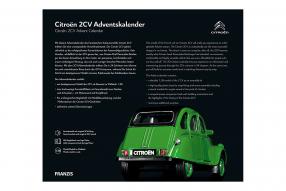If you ask a friend who is less interested in automobiles whether they know what a Citroen 2 CV is, you will usually get the answer “no”. If you then ask him whether he knows what a “duck” is in the automotive context, the question is usually answered in the affirmative. What is meant in both cases is of course the Citroen 2 CV, of which just over 3.8 million vehicles were built over a 41-year construction period (1949-1990). In the 60s and 70s, the duck was a popular vehicle in the student movement and probably achieved cult status in Germany at the latest at this time, which it has retained to this day. With its automotive Advent calendars, publisher Franzis ensures that our waiting time for Christmas is sweetened. If you want, you can put a duck in scale 1:38 into your showcase after just 24 days of construction. This is made possible by the Advent calendar from Franzis, which, in addition to the model kit, also contains a high-quality plastic base with a sound module. Anyone who buys the calendar will receive a comprehensive booklet with the model building instructions and the milestones of the 2 CV history. Numerous smaller surprises are also part of the set. The model's strong green tone is sure to be an eye-catcher regardless of where it is installed.
When Pierre-Jules Boulanger, the then director of Citroen, commissioned his designer André Lefèbvre to build a minimalist small car in 1934, the foundation stone for the duck was laid. The task given to Lefèbvre was to design a car that had space for two farmers in boots, a hundred weight of potatoes or a barrel of wine, had a top speed of at least 60 kph and would consume a maximum of 3 liters of petrol per 100 km. It should also be possible to cover bad stretches of road and have a suspension that is comfortable enough to ensure that even a basket full of raw eggs is not damaged when driving over a bumpy field. The designer should not take appearance into account when planning. What came out in the end is history. The 2CV was given the name “Duck” in 1948 by a Dutch journalist who christened the vehicle “lelijke eend” (the ugly duckling) based on Christian Andersen’s fairy tale.
In the 60s and 70s, the duck also became a cult vehicle in Germany. The purchase price was low and due to their small displacement the tax rate was also very low. While in 1999 there were almost 40,000 2CVs registered in Germany, in 2013 there are only a little more than 12,500 units, although these figures are not entirely accurate. Many of the vehicles registered in Germany are imported from other European countries and have the chassis number 0000. This makes it impossible to clearly identify the exact number of remaining vehicles. The last 2CV left the production halls in Mangualde (Portugal) on June 27th, 1990. If you add up all the series and model variants produced, then the duck has a total of 5.1 million units produced.
At the moment, the Advent calendar is available at the top price of €19.95.
Citroen 2CV Adventskalender: Citroen 2CV grün 1:38 Franzis, RRP €64,95, item-no.: 55154
产品
 | Citroen 2CV 降临节日历: Citroen 2CV 绿色的 1:38 Franzis | 19,95 € |











 [31.10.2023] Max Verstappen 2022: World-champion title in the cooldown room
[31.10.2023] Max Verstappen 2022: World-champion title in the cooldown room [25.10.2023] 24h days "nostalgia of the GDR" with the Advent calendar from Franzis
[25.10.2023] 24h days "nostalgia of the GDR" with the Advent calendar from Franzis
